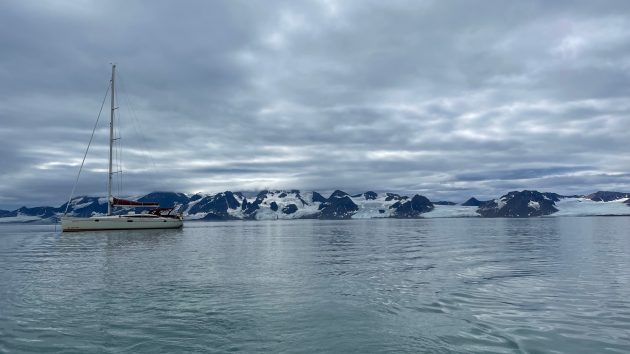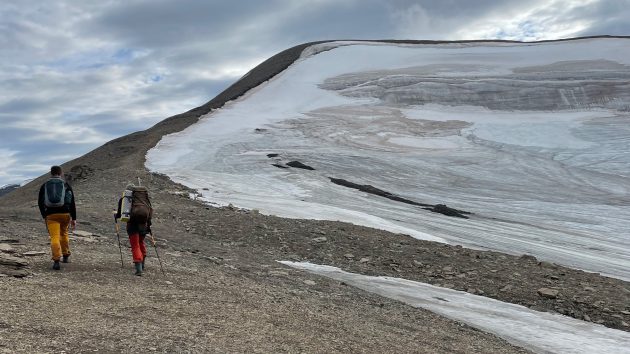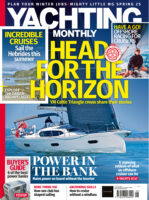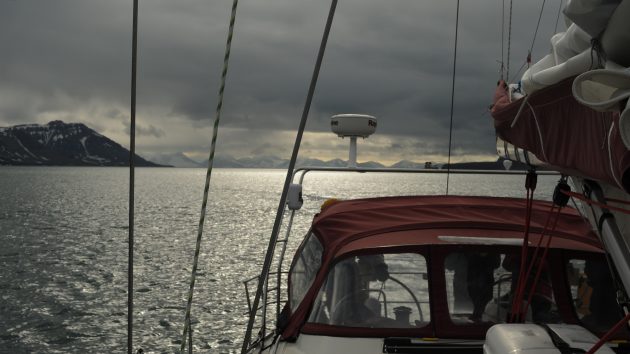Celebrating Norway’s majestic but imperiled Svalbard archipelago, Tim Linsell's piece is the Brian Black Memorial Award winner 2023 for environmental journalism
What do you think of whaling?’ I paused to consider my response as the ageing fisherman chomped down on his cheese sandwich. I had recently begun work as a skipper and expedition manager in northern Norway and was shortly due to sail to the Svalbard archipelago for the summer season.
I decided that now was not the time to expand upon my background working for a ship-bound study abroad program centred on marine science and environmental stewardship.
‘There are a lot of whales. I have seen them. And I have seen scientists lie about how many there are!’ The man’s 20-something son added with a righteously indignant passion. His father – still holding eye contact – took another hearty bite of amply buttered multi-grain.
As it became increasingly clear that the two had a stake in Norway’s diminished, but still very much active whaling industry, I decided that the ecological yet emotive parry that had been taking shape in my mind could wait. Instead, perhaps this was best seen as an opportunity to learn from a perspective diametrically opposed to my own. In the immortal wisdom of Kenny Rogers: ‘You’ve got to know when to hold ‘em, know when to fold ‘em.’

The 24 hours of daylight afforded ample opportunity to spot whatever life we might come across
Salmon farming
A week or so later we left Tromsø for the passage north to Longyearbyen where we would be based for the summer. And as I headed down the dock where the rest of the crew waited to throw our lines, I bumped into my lunchtime acquaintance. ‘You are leaving now for Spitzbergen?’ he said, referring to Svalbard’s largest island. ‘Well good luck, it is really a beautiful place.’
With a wink and a conspiratorial stage whisper he added, ‘The area is very good hunting. There are really very many whales.’ Thanking him and affirming that I was indeed excited about the life we might see along the way, I said goodbye and continued to the boat.
The region’s wildlife and natural beauty had indeed drawn my partner Lauren and me to the area, and this moment felt like a step into a parallel and magical universe. Sailing under the midnight sun through a landscape hewn by glaciers, where charts still refer to soundings from the 19th century, and where stories of encounters with majestic megafauna are commonplace.

The crew onboard
However, ecological damage need not be as striking as a harpooned whale. Turning to leave the protection of the islands lining the Norwegian coast, we passed through a maze of fjords, cut from the sheer rock faces all around. Against a backdrop such as this, you could be forgiven for missing the patchwork of low-lying circular floats and stilts.
And yet these open net-pen salmon farms are a major contributor to the local economy. Norway is both the industry’s birthplace and a production powerhouse – contributing 50% of the world’s total farmed Atlantic salmon with a yearly output valued at approximately USD 9.3 billion.
As innocuous as these structures seem, as this method of salmon farming has become the world’s fastest-growing food sector, the footprint of the industry has grown too. Each of these pens is filled with around 200,000 fish, producing vast amounts of waste and offering a rich breeding ground for disease and sea lice which devastate wild populations. Coupled with escapees at once outcompeting wild salmon while also reducing genetic diversity, this method of farming has drawn increasing attention and alarm from ecologists, fishers, and conservation groups.
For now though, all we see sailing past is a collection of pens set amongst emerald-green mountains and dark grey water.
Tragic decline
The first 24 hours were relatively fast and objectively uncomfortable as we learned how far to push the boat, what sounds and vibrations were normal, and what warranted further investigation. Early on we had agreed that if the team on watch was to see anything they judged to be particularly cool, they would wake up the others. The 24 hours of daylight afforded ample opportunity to spot whatever life we might come across.
Throughout the rise and fall of industrial whaling, the waters around Svalbard and Norway had been central. Though estimating the sheer scale of whale populations before the advent of commercial hunting is incredibly difficult, we know that the decline in numbers was precipitous. Early anecdotal accounts speak about vast aggregations in the fjords and bays of Svalbard. Guides told us stories of early explorers and whalers speculating about the possibility of walking across the breadth of a fjord on the backs of bowhead, fin, blue, and North Atlantic right whales.
Article continues below…
[colection]
We also know that industrial whalers selected those species that offered the greatest return on energy and investment. This meant that the largest species, and individuals, were targeted with the greatest fervour, leading some to hypothesise that the genes responsible for gigantism may have been wiped out.
While there have been success stories of population recovery post the 1986 moratorium on whaling – the Antarctic population of humpbacks a notable example – the level from which we gauge population recovery sets a low bar. For example, a 2006 estimate suggested that in 1890 the global blue whale population numbered around 340,000 but by 2001 had fallen to just over 4,500.

Indigenous peoples across the Arctic have sustainably hunted whales since time immemorial. This period of commercialisation, however, was an utterly new entity.
Despite this, of all the places to look for whales, we were passing through what should have been one of the richest areas on the planet. In addition, I had been told they were here by one who had spent the better part of their life on this stretch of water looking for marine mammals.
It was 0400, we were approximately 20 miles from Sørkapp – the southernmost point of the main archipelago – and I could just make out the faint outline of mountains.
Whales sighted
Having just briefed me on the events of the last four hours, Lauren was just turning to leave when I saw a blow in the distance. Huddling around the edges of the cockpit, we saw another… then another… and yet more still. Soon enough there was a separate, roiling mass 100 metres from the stern as we saw what looked like a pod of white-beaked dolphins feeding near the surface, interrupted as a whale lunged through the fray. For 10 minutes we were at the centre of a flurry of activity. Then, as abruptly as it had begun, the water’s surface once again fell silent.

The author
For the rest of the passage, and throughout the summer, this alternation of preternatural awareness and frenzied excitement would typify our journey.
As we continued from Longyearbyen, north through Forlandsundet to St. Jonsfjord and on to Kongsfjord and Magdalenefjord, it felt as though my mind were scrolling through past experiences to try to better conceptualise this space. Against an otherworldly backdrop of ice, rock, and ocean, a colony of walrus, a minke whale circling the boat, and a mother polar bear leading a cub across a distant shoreline offered spellbinding glimpses of this ecosystem.
But walking through Longyearbyen later I remember seeing a raging brown torrent of glacial runoff as I walked by in a T-shirt, just a few hundred miles from the top of the planet. A week earlier, departing from a bay near the base of a calving glacier, a guide with whom I was working pointed out the narrow accumulation zone at the top of the same glacier. In just the last few hours I had first heard and then seen what must have been hundreds of tons of ice thunderously wrenching free from the sheer face. And this thin ribbon of bright white at the glacier’s head represented all the ice that would be added for the entire season.

I was immensely grateful on that morning to see those grey-black backs in the mist
The Arctic is heating faster than any other region on the planet and seeing this cascade of runoff, these behemoths of sky-blue ice floating by, and feeling this heat beating down, you can sense the utter wrongness of what has and continues to happen here.
Shifting baseline syndrome was first popularised by Dr Daniel Pauly. Initially, the term was used to describe how successive generations of fisheries scientists accept the fish stock size and composition that they find at the start of their careers as the norm, latterly gauging alterations based on this, with the result that environmental degradation is downplayed over time.

Visitors to Svalbard today might get the chance to be awed by the majesty (and smell) of a walrus colony of 50 individuals without being aware that this is but a fragment of the former population of 200,000 individuals that has now been reduced to just 3,000.
Beyond optimism or pessimism, this is a call to at once appreciate the singular beauty of such spaces while being aware of the story of decline that our face-value appreciation may hide.
I have no doubt that the whalers I met honestly believed there to be a lot of whales in the Barents Sea. Indeed, I was immensely grateful on that morning to see those grey-black backs in the mist.
A call to action
I think that as sailors we are uniquely positioned to call out this decline. Firstly, I believe this because much of this ecological and environmental degradation is a consequence of viewing nature as being composed of exploitable resources, and of existing somewhere vaguely ‘out there’. But anyone who has clung white-knuckled to a wheel in a howling gale and breaking sea knows full well that this is not a space that has been conquered, but one that demands our utmost respect as we too depend on, and are at the mercy of it.
I also believe this because we come from a rich tradition of storytelling. This must be reconnected with and reinvigorated in order to muster our communities to demand the systemic changes that this moment demands.
Read all about the Brian Black Memorial Award for environmental journalism.
Enjoyed reading this?
A subscription to Yachting Monthly magazine costs around 40% less than the cover price.
Print and digital editions are available through Magazines Direct – where you can also find the latest deals.
YM is packed with information to help you get the most from your time on the water.
-
-
- Take your seamanship to the next level with tips, advice and skills from our experts
- Impartial in-depth reviews of the latest yachts and equipment
- Cruising guides to help you reach those dream destinations
-
Follow us on Facebook, Twitter and Instagram.





